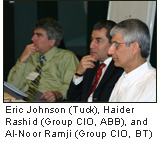
|
|
|
 |
|
 |
M&A and Divestitures: Integration and Disintegration Roundtable on Digital Strategies April 4, 2008 - London, England hosted by BT Group CIOs and other senior execs from ABB, BMW, BT Group, Erste Bank, Hilti, Holcim, and Nestlé were joined by academics from Tuck and IMD for this roundtable. |
||
| Press Release Agenda List of Participants Discussion Guide Overview Article
| |||||
While the fundamental question of merging, acquiring or divesting is an important and strategic decision for most firms, the devil is often in the integration or separation, the thought and due diligence that was given to it in advance, and the investment in it during execution.
In this roundtable, as we did in the recent U.S. roundtable, we focused on all aspects of mergers, acquisitions, and divestitures, but largely through the lens of, or with emphasis on, integration. While we discussed the rationale for and choice between affecting a merger or acquiring a company, examined negotiation and the various phases of execution and management, as well as looked at divestitures, it was with focus on integration/disintegration and associated issues, including especially the role of IT and IT integration or separation.
The participants' experiences and views yielded the following insights (see the Overview Article for a complete summary):
- Emerging markets are becoming a key focal point for global M&A activity, offering some of the most attractive opportunities, yet the greatest challenges to strategic acquirers.
- It's important to recognize and act on M&A 'windows of opportunity,' for example the current pause in private equity activity.
- M&A decisions should ideally be driven by business unit needs and strategic fit rather than corporate mandates and non-organic growth targets.
- Executives should treat forecasts, financial metrics, and valuation models as important tools, yet acknowledge their limitations and focus on the bigger picture behind the numbers.
- People are at the heart of M&A, and properly evaluating and retaining the key management and staff of an acquisition is crucial.
- Recognizing and managing cultural differences is crucial for realizing deal value; seemingly trivial differences can often be much more problematic than large obvious ones.
- Integration should be purpose-driven, with a focus on customer needs, on business model and processes, and on why you did the deal in the first place.
- The first 100 days are critical to the success of any deal. Communication, decisiveness, and clarity of expectations are among the key success factors.
- Knowledge, discipline, planning, and strategy are the keys to succeeding at M&A. Encourage learning from past successes and failures, and donít forget to sweat the details.
| M&A and Divestitures: Integration and Disintegration (U.S. Roundtable) - Thought Leadership Roundtable on Digital Strategies | |
| Strategic Partnering: Managing Joint Ventures and Alliances - Thought Leadership Roundtable on Digital Strategies | |
| The CIO as Strategic Business Partner: Leading Change and Driving Results - An Executive Workshop | |